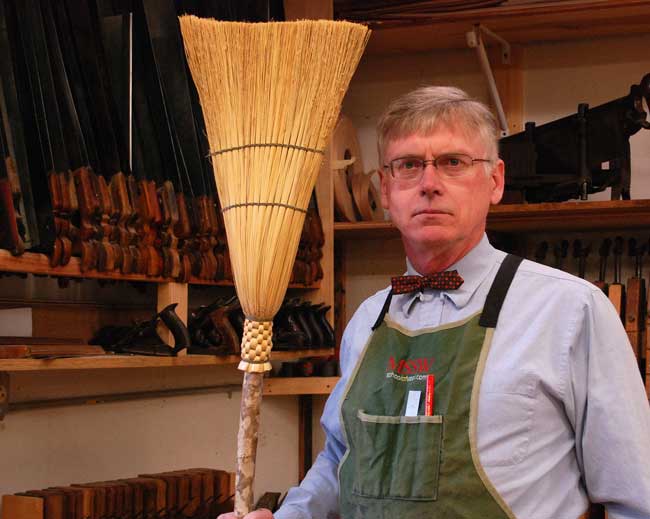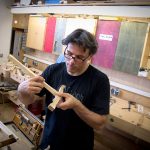We may receive a commission when you use our affiliate links. However, this does not impact our recommendations.
I’ve been a woodworker for a few decades now and read many a woodworking text and tome and have yet to read an article on how to sweep. Sweeping is the first job any woodworker learns but I find that there are actually few who can do it well, they stir up a cloud of dust and leave debris under machines and benches with no thought given to the proper size or type of broom.
The Shakers are credited with creating the flat corn broom and popularizing it. Their maxim “Cleanliness is next to godliness” encourages a tidy working and living environment. While godliness may not be every woodworker’s goal, cleanliness is attainable and wisely sought after. Maintaining your shop is every bit as important as maintaining your tools.
Why is a beginning woodworker simply handed a broom and sent to sweep with no regard to learning this important skill? In “The Joiner and Cabinet Maker,” sweeping is well described as an important task requiring care:
“Now a joiner’s shop is not expected to be as clean and tidy as a parlour; shavings, and sawdust, and chips are constantly being made, and without them it would appear that no work was being done. But they must not be allowed to lie till they are in the way; and the apprentice must regularly remove them to their proper places. In picking up the shavings he must be careful to take them in handfuls and shake them before he stuffs them into a bag; for it often happens that tools have fallen amongst them from the bench, or pieces of wood that have been prepared for some part of work at hand, or small bits of hard and valuable wood that are too good to burn. The careful apprentice, who picks up all these things and returns them to their proper owners, will find both master and men ready to thank him and reward him by helping him in many ways in his business.”
The awareness that not everything on the floor is trash is lost on many; other than the occasional coin, most sweepers just collect everything that is on the floor and toss it out. A skilled sweeper, however, watches what he is sweeping up and if he comes across a nut or screw he tries to see if it fell out of a machine or off of a nearby workbench. Many times bolts fall straight down from where they belong – and by being put back where they belong can save a costly repair or prevent a dangerous situation. Pieces of wood on the floor may be part of a project and not just scrap. The good sweeper learns to see and differentiate between the two.
In my early years I was a sweeper in a large printing firm. I saw everything and I knew where everything was; I had full access to every part of the place; I gained a fair amount of knowledge about photo offset printing and engraving. I believe this access to the entire shop is why an apprentice is first given a broom: it is an open window to the entire shop, a way to see what all of the different workers are building and the methods they bring to the task at hand. It enables the sweeper to get to know all of the workers fairly quickly and helps him find his place in to the shop environment.
Chose the proper tool. Brooms, like planes, come in different shapes and sizes. Choose the proper size for the task at hand: a small brush for the mouth of a plane; a larger bench brush for sweeping off machines and benches; a flat broom for getting into corners and along walls; and a larger push broom for open areas. Learn to use the tools properly. A gentle forward motion gives a clean surface. Pushing down hard and sweeping fast with quick short strokes only causes the bristles to flip dust in the air. Your sweeping should put very little dust in the air to settle back down on your clean shop and in your lungs.
Like a good sharpening station your brooms should be easily and readily available so you can get the job done and get back to work. Like any other tool, brooms must be in good repair to do their job well. Depending on the floor surface you may want a soft or a stiff bristle. Stiffer bristles tend to be for rougher floors and put more dust in the air; softer bristles work better on smoother floors and leave a cleaner surface. A rough surface that puts a lot of dust in the air might be best swept with the aid of sweeping compound which keeps the dust down.
The importance of a clean shop is always evident to the worker who loses a chip of wood or a screw or bearing in a pile of shavings, wishing the floor was clean will not help you find that tiny chip or screw after it is lost in the mess on the floor. Tripping hazards caused by chunks of wood and fine dust are eliminated, fire danger is lessened and when visitors stop in the shop looks better, and your carts will roll easier!!
If a project is going badly or you are hung up on a design issue, put on some music and sweep, you will find that it calms and clears your mind as it clears your shop, and you may even find a quarter.
A clean shop is a happy shop.
“Let everyone sweep in front of his own door, and the whole world will be clean.”
Johann Wolfgang von Goethe
• Mike brings his inimitable sense of humor and his 35 years of experience to Woodworking in America 2013 – as he has every year as the brains behind the Hand Tool Olympics. And this year, he’s also joining us in the classrooms to teach “The Thrifty Woodworker. In this session from one of the most practical and frugal woodworkers you’ll ever meet, you’ll discover tool solutions that won’t break the bank – including a perfectly serviceable kit of tools for dovetailing for less that $20. Plus, you’ll learn how to refurbish old tools so that you can turn a flea-market find into a favorite tool.” Register today at WoodworkingInAmerica.com.
p.s. We’re opening up the PWM Contributors’ Blog for reader posts from select authors. If you’re interested, send a note to Megan Fitzpatrick for more information.
Here are some supplies and tools we find essential in our everyday work around the shop. We may receive a commission from sales referred by our links; however, we have carefully selected these products for their usefulness and quality.










Reminds me of a lad named Steve who was hired to work in the shop and clean up or what ever to help out. One day he had a push broom and was very slowly raking up debris when I asked him if he knew what the tool he was using was called.
He said “a push broom ?”
I said “Well?”
His velocity and accomplishments increased instantaneously.
Hey Mike.
Great article. How true it is. When I loose a small part and don’t see it any where, I begin to organize and sweep finding all sorts of little washers etc. I am, after all, my own apprentice. Most importantly, it does indeed give me a chance to gather my thoughts and organize my scattered marbles, in between steps of a project. Or perhaps just needing a diversion from the frustration of a day gone bad. Thanks again and best wishes, Ron
It is very true that a good sweeper picks up non-trash items. I worked at a home building business as a laborer. When we would clean up between projects and sectional rotations, workers would just sweep up everything and put it in the trash. I, however, did not do the same. I collected all extra and miscellaneous bits and bobs and set them aside. I showed the foreman what was being tossed out. He couldn’t believe that workers were tossing out a minimum of $200 worth of hardware per shift. No wonder the company went bankrupt.
Plane shavings make excellent kindling for errant sparks. I clean my shop every single day. Plus it keeps the wife happy.
Mike forgot to mention that his broom also doubles as a polissoir.